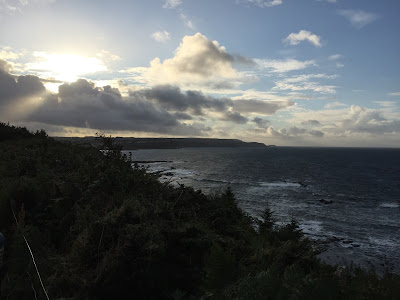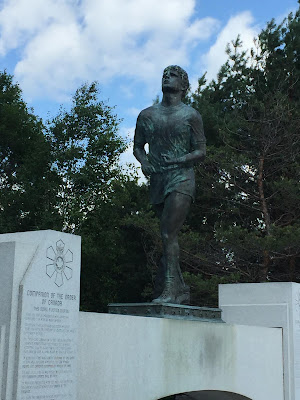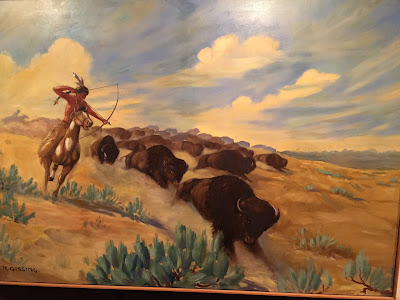Ottawa to Victoria with a few stops along the way
Background for this journey....
After finishing my Habitat for Humanity trip to Iqaluit (August 2017) and flying back to Ottawa from the North, I made a big transition in starting the road trip from Ottawa to Victoria in my new car! When my son, daughter-in-law and grandson moved to Yellowknife in July 2017, I purchased their like-new 2015 VW Tiguan (less than 5,000 km), picked it up in London, ON and drove to the Nation's capital where it was left until I returned about a week later.
Why take the long
drive?
When in grade school, geography and history courses
created a deep interest in me to explore Canada and visit the places I could
quickly point out on a map. Later, when in my undergraduate years at the
University of New Brunswick, I traveled to Vancouver four years for summer jobs at Palm Dairies in Vancouver. At the beginning of two summers on the west coast, I
purchased cheap older cars that I then drove east to New Brunswick at the end
of the summer. Those were long drives in cars that had seen a lot of life
before I purchased them, but I enjoyed every kilometre stopping in places like
Kamloops, Medicine Hat, Maple Creek, Mattawa, Edmundston and many more.
The desire to travel stayed strong with me and when I joined the
CBC early in my career, it wasn’t long before I started traveling
to various parts of Canada in conjunction with my job. By the time I left CBC after more than 16 years, I had visited every province and territory in Canada, some several times.
Opportunities like these are rare for most Canadians and am grateful that I was
able to travel, to see and learn so much about the country. When moving from Toronto to
Victoria, we drove and once again it was a wonderful experience.
For a few years prior to August 2017, I had thought it
would be fun to do another cross-Canada trip by car. I know Ottawa-to-Victoria is not exactly all of the country, but it covers a long distance with much to see along the way and, in a way celebrate Canada's 150th birthday year. Before setting out on this road trip, I didn't have many details planned except there were a few places that I definitely wanted to visit. It was my hope that the drive have opportunities to increase my awareness and understanding of indigenous people and cultures in Canada.
Here are the distances covered each day and where I stayed overnight.
Day 1: Ottawa to Sturgeon Falls (ON) –
396 km
Day 2: Sturgeon Falls to Wawa (ON) –
619 km
Day 3: Wawa to Kenora (ON) – 948 km
(stopped at Terry Fox Memorial)
Day 4: Kenora (ON) to Moosomin (SK) – 569 km (visited Human Rights Museum in Winnipeg)
Day 5: Moosomin to Swift Current (SK) – 467 km (lunch in Regina with former CBC colleagues)
Day 6: Swift Current (SK) to Taber (AB) –
637 km (side trip to Old Man on His Back Prairie
and Heritage
Conservation Area)
Day 7: Taber (AB) to Castlegar (BC) – 633 km (visited Head Smashed In Buffalo Jump)
Day 8: Castlegar to Victoria –
709 km
On the Road Again
Day 1: Before starting the journey on August 20, I had a wonderful catch-up over coffee and walk with my dear friend Wendy in Ottawa. Then, I drove almost 400 km to Sturgeon Falls where I stayed overnight. The scenery is so beautiful in this part of Canada, but I was focused on driving so no photos. Had dinner at a place recommended by the woman
at the front desk at the motel – Jean-Guy Rubberboots where “whatever happened
at Jean-Guy’s never really happened.”
The Cattle Castle - Lansdowne Park (Ottawa)
Sturgeon Falls
Day 2: The second day of driving was over a much longer distance as I covered 620 km before stopping in Wawa. Wawa was established as a fur trading
community and later thrived on mining (gold and iron) and lumbering. The major
indigenous people in this area are the Ojibwe people. A major landmark in Wawa is its giant Canada Goose statue that,
after 57 years, was replaced with a new one on Canada Day earlier in 2017. The new
statue is 8.5 metres high and weighs 2,700 kg. Near the goose are two carved wood
statues called Gitchee Gumee, which is the Ojibwe name for Lake Superior,
the largest of the Great Lakes. It has different interpretations with two being
"the shining blue sea water" and "great water." Gordon
Lightfoot’s song “The Wreck of the Edmund Fitzgerald” refers to it as the "big lake they called gitche gumee; the lake it is said never gives up her dead."

Wawa also has a history of being considered the worst
place in Canada for hitchhikers to be stranded for long periods before catching
another ride.
The drive from Sault Ste. Marie to Wawa along Lake
Superior is beautiful as the highway moves into the Canadian Shield with plenty
of deciduous trees, rolling hills and the rugged shoreline of the largest of
the Great Lakes.
Lake Superior
Lake Superior
Lake Superior
Lake Superior
Day 3: It was a very good but long drive on day three (948 km) with Kenora being the overnight stop – a place I had driven past on three
previous cross-country drives. While the drive was long, I made several short stops to
break up the drive and take in the beautiful scenery of Lake Superior and the Canadian
Shield. The stop at Aguasbon Gorge and Falls just off the Trans Canada Highway
near Terrace, which was a pleasant surprise at a place I’d never heard of. The
photos below show why it was a great stop.
Aguasbon Gorge and Falls
Aguasbon Gorge and Falls
Before setting out, one of the planned stops and the most important stop on day three was the “Terry
Fox Memorial” just east of Thunder Bay. At the age of not quite 19 years, Fox was
diagnosed with bone cancer in his right leg and decided to have the leg
amputated a bit above the knee. While recovering in the hospital, he was
overcome by the suffering of other cancer patients which led to his decision to
run across Canada to raise money for cancer research. In 1980, he embarked on
his "Marathon of Hope" from Canada's east coast. Even with one leg
amputated, he ran an average of 42 km (26 miles) for 143 days for a total of
5,373 km (3,339 miles) before he was forced to stop east of Thunder Bay because
cancer had appeared in his lungs. What an inspiration!!
Terry Fox Memorial
Terry Fox Memorial
Terry Fox Memorial
Day 4: This was another long day,
but it was more than the drive of 569 km. As planned, I visited the
Canadian Human Rights Museum for four hours and could easily have stayed longer
except I was tired. The museum is located on the ancestral lands of Treaty One
Territory. These lands are also known as the heartland of the Metis people. The
building is easily accessible in all areas and has places set aside to sit and
reflect.
One thing that stands out when approaching the building
is the following statement: "All human beings are born free and equal in
dignity and rights." Throughout the museum, it is stressed that wherever
we live, whatever our age, gender or nationality, regardless of colour,
religion, language, ethnic background or any other status, we are all entitled
to human rights. Always! Our rights and freedoms may be expressed in many ways –
on paper, in our traditions, and in how we choose to live our lives and treat
others. While I knew all of this previously, this was a powerful reminder.
Human Rights Museum - Winnipeg
On the walk way to the museum
It is a very large museum, well organized and makes
excellent use of video, photos, and an array of displays. In terms of content, human
rights themes and stories of many diverse groups and individuals are woven into
the galleries, displays and architecture.
I was interested in all of it, but especially in the sections
dedicated to "Canadian Journeys" and "Indigenous Perspectives."
While there is a strong emphasis on the steps and missteps in our country's history,
there are many stories to inspire change and ways to participate are also
emphasized.
After time at the museum, I drove to Moosomin, SK and stayed
there overnight. There was much to reflect upon as I dropped off to sleep.
Day 5: This was relaxed day with
less driving and the highlight of the day was having lunch with three former CBC
colleagues in Regina. Having left the CBC more than 25 years ago, it has been great
to keep these connections and friendships alive. It was fun to catch up, know they are well and share a few stories.
On the way out of the city, I drove past the new Mosaic
football stadium - very impressive. It would be fun to go to a Riders football game
there. Once out of the city, the driving was again through farm
country, which is major attraction of road trips in Saskatchewan. Wheat
harvesting in the south is well underway with many fields just waiting for the wheat harvesting equipment to arrive!
Again with no specific destination in mind, I decided to
stop in Swift Current after 470 km of driving.
Ready for harvest
Day 6: This was one of those days I will not forget (it's
good). Until last evening I had a different plan for today than what happened,
but it is always good to be flexible.
Yesterday, I received an email from my friend Nancy in Victoria and
she was hoping I was still in SK. She sent a link about a very special place in
Southwestern Saskatchewan called "The Old Man on his Back Prairie and
Heritage Conservation Area" (OMB). This area is the ranch previously owned by
author Sharon Butala and Peter. The ranch is central to much of her writing and
I always was drawn to the sense of place she vividly described.
A few months earlier I read a short piece about the ranch
being gifted to the Nature Conservancy of Canada. Until yesterday, I did not
know this had actually happened. Because of Nancy's encouragement, I decided the diversion would be a great idea. As another friend (Alec) would say, it had to be done. The diversion to OMB added an extra 306 km of driving and it was worth every km. Except
for the last 15 km of dirt road, the drive was on paved road.
OMB covers an 5,300 hectare area that will be protected
for the long term. It is a prairie grassland ranch with sustainable grazing for
cattle and s herd of genetically pure plains bison were introduced in 2003. It
is an excellent example of a positive relationship between agriculture land use
and conservation. There is plenty of wildlife too - hawks, burrowing owls,
coyotes, swift fox, pronghorn, mule and white-tailed deer, and Bison. A variety of grasses
also contribute to The biodiversity.
Much of the land in Southwestern Saskatchewan (Cypress
Hills and Frenchman River Valley) is under threat from cultivation.
Fortunately, the OMB is surrounded by federally and provincially owned
community pasture, thereby keeping a very large intact native prairie.
While there is a visitor centre on the homestead, no one
was around. So I wondered around for a bit in a truly secluded and special
place. Shortly after leaving the homestead I came across a coyote in the middle
of the road and a couple of minutes later a pronghorn was standing in the
middle of the dirt road. Seemed like a fitting end to my visit.
Homestead
Homestead
Not a good photo, but that's the coyote
After returning to the Trans Canada highway, I headed west and at Medicine Hat took the Crow's Nest Highway; this section of the drive until I got well into BC was new to me. My overnight stop was in Taber. The southern Alberta town of about 9,000 people is famous for its high quality corn and country singer Corb Lund.
Day 7: One of my planned stops occurred shortly after leaving Taber when I stopped at
Head-Smashed-In Buffalo Jump. In 1981, it was designated as a
World Heritage Site by UNESCO. It may be the oldest, largest and best
preserved of many buffalo jump sites across the western plains. It is a very
important historical and cultural site that preserves and interprets the
significance of this location as an ancient communal hunting ground used by the
Plains People for nearly 6,000 years.
According to one Blackfoot oral tradition, a young boy
wanted to witness the plunge of countless buffalo as people drove them over a
sandstone cliff. Standing under the shelter of a ledge he watched the buffalo
fall past. On the day the boy was there, the hunt was especially good and, as
the bodies mounted, he became trapped between the animals and the cliff. When
the boy was found, his head was crushed by the weight of the buffalo carcasses
and the site then became known as Head-Smashed-In.
Simulation of the Buffalo jump
The site has an excellent interpretive centre that has a wide range of information, images and displays on how the buffalo
jump worked and how the beasts were carefully herded into the "drive
lanes" that extended over 8 km and gradually narrowed as it got closer to
the cliff. The centre also illustrates how virtually all of the buffalo were
used for food, blankets and other useful things.
Some areas above and below the cliff can be accessed on
foot, which is a good way to gain a sense of what would have happened. Over the
centuries, the buffalo bones below the cliff built up by an estimated 10 metres
leaving what is about a 10-metre high exposed cliff drop today. The original
cliff drop would of course have been much higher.
In addition to being an attraction to visitors, the
centre is used for educational programs and helping keep alive traditions and
customs of the Plains People. One display area that I found especially
interesting was of paintings by Blackfoot telling stories from their traditions
and legends.
After driving 633 km, I reached the BC town of Castlegar where I stayed overnight. It was an interesting drive through southern BC - beautiful scenery and attractive towns such as Grand Forks and Creston.
Day 8: The last day of the road trip! My focus was completely on driving except for a few stops for coffee, fuel and food. After about 700 km of driving, I reached BC Ferries terminal in Tsawwassen and was able to catch a ferry to Vancouver Island without a long wait.
Sunset as the ferry approached Vancouver Island






























































